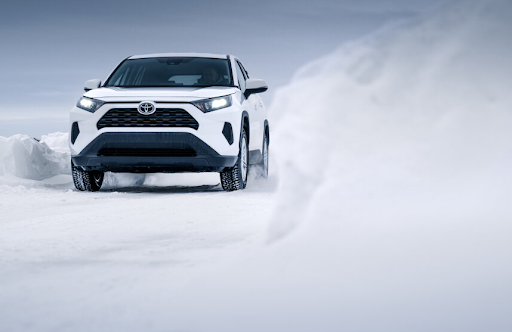Winter brings with it a few factors that affect driving, vehicles, and tires. Aside from snow, ice, and slush, the cold itself has an impact to be cautious of.
Just as hot temperatures affect rubber, so too do cold temperatures. We’ll help you understand the science behind cold temperatures affecting rubber and tire performance.
How cold weather affects tires
Rubber
Tire rubber is less affected by snow and more affected by its surrounding temperature. Even the best all-weather tires are affected by a drop in temperature, one of the many reasons winter tires are always the best choice for freezing temperatures and heavy snow or ice.
The rubber compound of winter tires is designed to remain soft during cold weather where other materials would usually harden. The rubber is meant to stay soft so it can continue to grip the minute imperfections in the road and create traction as it drives.
If the rubber were to harden as the temperature drops, it wouldn’t have the same ability to grip the road which would be even more detrimental given the already slick roads that come with cold weather. A rigid tire also reduces the surface area that’s against the road, similar to an over-inflated tire.
All-season tires won’t perform as well during the winter because they need to perform in the summer as well. They can’t remain soft in the winter if they also need to be firm in the summer. Winter tires should be installed when temperatures are expected to fall to or below 7°C.
Loss of traction
On top of the harsh driving conditions during winter that wear away at the treads, the cold temperatures add to the inability of an all-season tire to grip the road. Worn tires have reduced rolling resistance which leads to poor handling, and poor handling increases the likelihood of slipping which can get out of hand quickly with tires that aren’t offering the right amount of traction. Instead of risking an accident, use winter high-performance tires.
Who is affected?
When it comes to a drop in temperature, regardless of other weather conditions (snow and ice) the following cohorts are affected and should switch to winter high-performance tires as soon as possible:
- Drivers in regions where the temperature reaches 7°C or lower.
- Drivers using summer, all-season, or all-weather tires during the winter.
- Drivers who want to increase their control and safety on the road in cold weather.
Risks to all-season and all-weather tires below 7°C
If you choose to continue using all-season or all-weather tires at this temperature, know that there are risks to the tires, and thus, your vehicle and yourself. These tires don’t have rubber compounds that are meant to withstand cold weather. They’ll become rigid which leads to an increased chance of cracking or damage, especially on rough surfaces that typically accompany cold weather.
Damaged roads and potholes
Roads experience a similar problem with temperature. Molecules shrink, slow, and provide more space in the cold so water can get in. Then the water freezes and splits or cracks the concrete.
This creates cracks and potholes in the winter with the rise and fall of the temperature. These surfaces are that much more damaging to a brittle tire which already has less give. Avoid this issue with high-performance tires designed for winter.
Maintaining tires in cold climates
There are only really two safe options to maintain tires in cold climates.
- Drive with winter tires. In this scenario, you’re able to continue with all of your regular driving using tires manufactured for the cold and will do better than others at keeping you safe and in control. If not winter tires, at least choose the best all-weather tires.
- Drive as little as possible if you aren’t using winter tires. While it’s not suggested you drive in the winter without winter tires, maybe you haven’t gotten them switched yet, or you aren’t financially able to. In that case, only drive when necessary and take great care. Avoid road hazards like potholes and cracks. Take care of your tires and store your vehicle in the garage if possible to somewhat manage the temperature and air pressure within the tires.
Choose Sailun for safe driving
It’s important to make safe driving decisions when the weather is against you. Already you probably drive slower in the winter, leave more space between you and the car in front of you, and have tools on hand in your vehicle that will help you navigate the snow (shovels, ice picks, extra windshield washer fluid, etc.).
Don’t leave it at that. Get a new set of high-performance tires at Sailun which are proven to help you stop faster on slippery roads and navigate rough terrain. Get started now.


